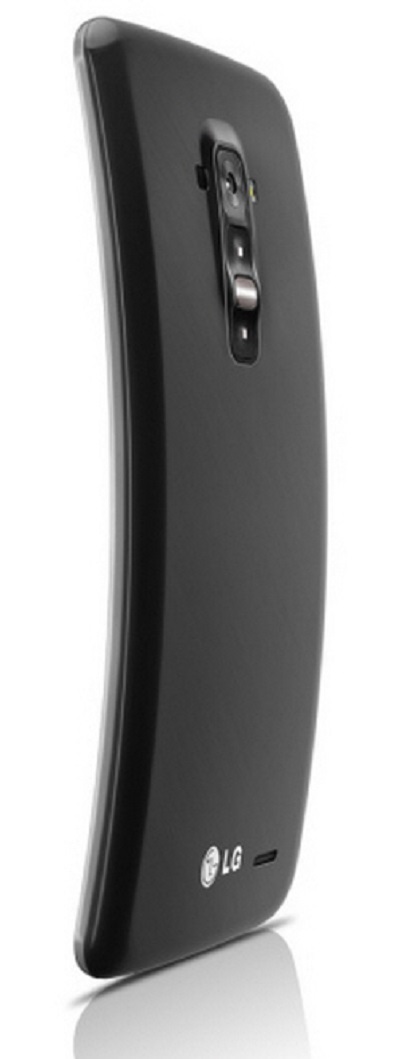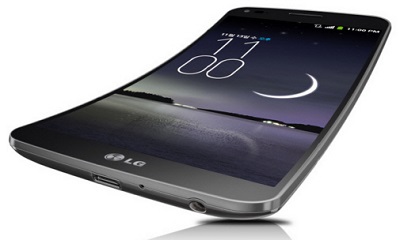One can certainly see that LG continues to remain busy, driving itself in a number of interesting directions and seeking at every term to deliver "innovation." Back in the first week of August, the company announced its new G2 smartphone, which moves any and all buttons/keys to the back of the case. It's a very interesting design idea though we're not sure if it has inspired much in the way of consumer sales. Just a short ten days ago LG's chemical arm, LG Chem, announced that it had developed the ability to create two types of "flexible" batteries, and that it was at work on finishing the development of a third. We'll come back to the flexible batteries.
Over the recent weekend, due apparently to a series of leaked photos -- the very same affliction that caused Samsung to have to announce its Samsung Galaxy Round curved smartphone back on October 9, -- LG found itself having to announce its own new G Flex smartphone. The new smartphone -- which we more or less covered as a mere LG curved design concept on October 3 -- has now officially materialized as the LG G Flex. AQs is the case with the Samsung Round, the LG G Flex will only be available in South Korea when it launches, and no indications have been provided for the new device to appear elsewhere.
Interestingly, LG claims the G Flex, which is equipped with a six inch display, is the world's first "real curved smartphone" -- certainly an interesting statement considering that the Samsung is also a very real curved smartphone that came out ahead of LG.
What LG actually means, however, is that the G Flex curves "the right way" -- across its horizontal axis rather than the vertical axis. Here is what it looks like and you can see that the curve is exactly the opposite of how the Samsung Round is curved.

Image courtesy LG
We do underscore that the term "flex" is a misnomer as there is nothing flexible about either the Samsung Round or the LG G Flex. The curves are fixed in both devices, and the screens simply follow the curves of the device cases.
In truth, the LG curve such as it is does make more sense relative to how a user holds a phone, and the general curve that is involved when considering overall ear to mouth geometry and facial contours. The curve further mimics something we’ve seen before-- if you look at the image below, the geometric angle would typically be found on opened-feature flip phones. The Samsung's vertical curve doesn't demonstrate anything remotely useful along these lines.

Image courtesy LG
And yet, we find absolutely no inconvenience whatsoever in using any non-curved smartphone! There is no worry in this day and age of the microphone not being properly positioned, so what does it really matter? It actually doesn't. It becomes a "feature" simply because LG and Samsung are now both able to deliver curved screens. LG claims the following benefits:
- The curved form increases the sound level by 3dB compared to typical flat smartphones;
- The curved design offers a more reassuring grip and fits more comfortably in one's back pocket;
- The LG G Flex delivers on the back-of-case placement of buttons/keys, as first introduced in the G2 -- there are no buttons on the sides or the front bezel;
- In landscape mode the display offers an IMAX-like experience, with the result being the most comfortable viewing angle for watching videos or playing games.
We remain skeptical that any curved smartphone will sit well in anyone's pocket, much as LG may tout this as a feature for one's "back" pocket. We keep ours in our shirt pocket and we simply don't see how any curved device will find a happy home back there -- or a happy user.
Hardware Innovation
LG added as well a unique twist to its announcement. It claims that the back of the case has a coating that is made of a material that actually "self-heals" from daily wear-and-tear scratches and nicks. LG claims that within a few minutes the scratch will simply disappear. Well, this may actually be far more interesting than the curve the LG G Flex delivers on! Will it really work? Who knows … we'll wait for one of the major gadget sites that details this sort of thing to weigh in and take all sorts of sharp objects to it. We suspect LG means extremely light nicks and scratches are likely to find themselves more or less "buffed out" by the same daily usage wear that causes nicks and scratches.
LG claims that the G Flex's 6" display deliver's the world's largest Plastic OLED (POLED) display developed and mass produced specifically for smartphones. The POLED display technology is ultra-thin, ultra-light and quite flexible. The panel, provided by LG Display, is built on plastic substrates instead of glass and delivers significant levels of durability. LG also claims the POLED display is brighter and generally more precise thanks to the application of what LG refers to as "Real RGB" -- which means that all three sub-pixels of red, green and blue -- are contained in one pixel.
Another LG company, LG Chem, has developed what it claims is the world's first curved battery technology, which it did specifically for use in LG G Flex. The new curved battery is designed with LG Chem's patented Stack & Folding technology, which specifically targets reducing the "physical stress" on a battery pack when it is curved.
The technology also provides better stability and overall performance -- by performance LG means that although the battery is quite thin and shaped into a curve, it still manages to deliver a very hefty 3,500mAh -- more than enough power, keeping in mind the giant 6" display, for more than a full day of use. Of course the POLED display is also less power hungry.
Mass production of the curved battery only recently ramped up to production level this month. Obviously the battery is untested in the field, but we suspect it will deliver as promised.
LG Chem also has two other battery designs up its sleeve. It refers to the first of these as a "Stepped Battery." It's a design that involves the use of two batteries that can be configured to take advantage of otherwise dead space within curved device designs. It is also useful for filling in space around the rear button design of the LG G2. LG claims battery density and hence the amount of time it delivers a charge is also improved up to 16 percent.
Finally, the company says that it is working on what it refers to as a waterproof "Cable Battery" that specifically targets bendable and wearable devices. This battery is still in development.
LG refers to all of this as "innovation through collaboration." It certainly is, as each component from each different LG company delivers to the overall design of the G Flex.
Software Features
As might be expected, the LG G Flex delivers on the same collection of capabilities the LG G2 offers: MP3, CD quality or 24 bit/192kHz Hi-Fi playback, KnockON, Guest Mode and Plug & Pop. In addition, the he LG G Flex adds the following:
- QTheater gives users quick access to photos, videos and YouTube right from the lock screen. by touching the screen and dragging outward along the curved surface with both fingers, the apps appear with the effect of theater curtains being drawn;
- Dual Window divides the wide 6-inch screen into two separate windows for more effective multitasking;
- Swing Lockscreen alters the image on the lock screen depending on how the G Flex is held;
- Face Detection Indicator displays the LED on the Rear Key in green to confirm status of face detection and focus;
- Camera Timer flashes the Rear Key LED to indicate that the countdown has begun;
- Urgent Call Alert flashes the LED on the Rear Key in red when several consecutive calls from the same person go unanswered.
Quite honestly, none of these things actually rely on a curved screen! This is also the case with Samsung's Galaxy Round's unique features - which the company similarly pegged to its curved screen.

Image courtesy LG
LG also suggests that using the curved display, which we need to note is only 720p, when used in landscape mode to watch movies, football games and so on, delivers on a more immersive experience, likening it to a curved large screen TV. We're quite dubious of this on such a small screen (even at 6"), but there is no real way to tell until actually viewing it. We suspect there will be a few people who will find it more immersive, but we would have to really wonder about them.
The LG G Flex will only be available in South Korea through all three major local carriers starting in November. Availability in additional markets will be announced at a later date. That both the LG and Samsung devices will only be available in South Korea leaves us thinking that these launches were made due to the numerous leaks each company had to handle with their respective curved products.
Key Specifications
The overall specifications for how the LG G Flex will ship in South Korea are noted below.
- Processor Chipset: 2.26 GHz Quad-Core Qualcomm Snapdragon 800 (MSM 8974);
- GPU: Adreno 330, 450MHz;
- Operating System: Android Jelly Bean 4.2.2;
- Display: 6-inch HD (1280 x 720), Curved P-OLED (Real RGB);
- Memory: 2GB LP DDR3 RAM / 32GB eMMc;
- Cameras: Rear 13.0 MP / Front 2.1 MP;
- Video: 720p;
- Networks: LTE-A / LTE / HSPA+ / GSM;
- Connectivity: BT 4.0 / USB 3.0 compatible / Wi-Fi (802.11 a/b/g/n/ac) / NFC
- Size: 160.5 x 81.6 x 7.9 - 8.7mm;
- Weight: 177g;
- Battery: 3,500mAh (embedded);
- Color: Titan Silver
- Other: TDMB / Hi-Fi 24bit, 192kHz Playback
The LG G Flex is certainly interesting. How well the entire device comes together remains to be seen.
Edited by
Rory J. Thompson
 QUICK LINKS
QUICK LINKS